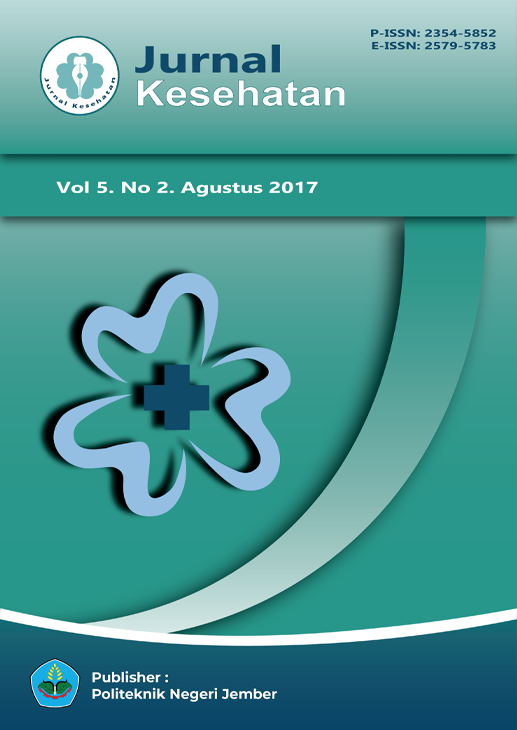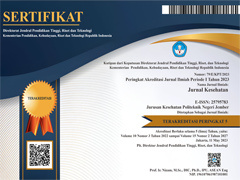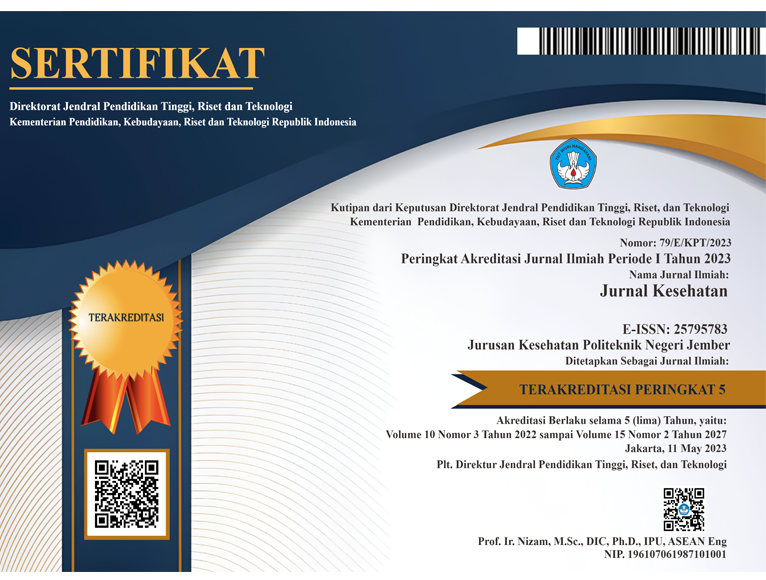Perilaku Merokok Pada Masyarakat Dan Implementasi Kebijakan Kawasan Tanpa Rokok (Ktr) Di Desa Ajung Kecamatan Kalisat Kabupaten Jember
DOI:
10.25047/j-kes.v5i2.30Downloads
Abstract
Smoking behavior has become an important issue of public health around the world since the last decade. Indonesia is one of the developing countries which has the highest level of cigarette consumption and production. A large number of studies have shown that smoking behavior can cause adverse effects for health, but conversely, the number of smokers increased every year. Nowadays, the trend of smoking behavior has entered the category of younger age between 13 – 15 years old. The purpose of this research is to obtain a description about smoking behavior on people and about the implementation of “no-smoking area” policy in Ajung village, Kalisat district of Jember. This study uses a descriptive research design with observation method. This study was conducted in May 2014. The sample in this study is 56 peoples and 4 elementary schools. Variables researched in this study are the knowledge of smoking adverse effect, smoking activity, the age of first smoking experience, the number of cigarette smoked per day, and “no-smoking area” policy. The results of the study have shown that 60,87% respondents have knowledge about smoking adverse effect toward respiratory disorders, respondents who have smoked daily activity are about 19.64%, the majority of respondents start smoking at age of 15-19 years, the average of respondents smoking as many as 13 stems in a day, and only 2 elementary schools that disposed to implement the “no-smoking area” policy in their institution. Based on these results, it is recommended the more intensive counseling about the hazards and the adverse effects of smoking behavior from various related institutions (health services, social services). Local governments is suggested to make regulations which aims to implement policy about “no-smoking area” in all institutions.
References
(1) Mardiani,T.H. Jurnal: Bahan Kimia dalam Rokok, Fakultas kedokteran, Universitas Sumatera Utara. http://www.library.usu.ac.id. (12 Agustus 2012 Citation). 2004
(2) Kosen,S. Perhitungan beban Ekonomi Tembakau berdasarkan Data Penyakit dan Biaya RS 2005. Dipresentasikan pada KONAS IAKMI 2007. Tidak dipublikasikan. 2007.
(3) Departemen Kesehatan. The Tobacco Sourse Book: Data to Support a national Tobacco Control Strategy. Jakarta. 2004
(4) Notoatmojo.Metodologi Penelitian Kesehatan.Jakarta:PT Rineka Cipta. 2010
(5) Subroto, H. Pengaruh rokok terhadap timbulnya PPOM. Penyakit Obstruktif Menahun patogenesis dan pengelolaan menyeluruh. Badan Penerbit Universitas Diponegoro, Semarang. 2004
(6) Bernida I, Yunus F, Wiyono WH, dkk. Faal Paru dan Uji Bronkodilator pada Perokok dan bukan Perokok. J Respir Indo, June 21, 2003 ; 10:4-11. Cermin Dunia Kedokteran
(7) Adams ML, dkk. The Relationship Between Tobacco School Policies and youth Tobacco Use. Journal of Scholl Health, 2009;79:17-23
(8) Prabandari, dkk. Kawasan tanpa Rokok sebagai Alternatif pengendalian Tembakau Studi Efektifitas Penerapan Kebijakan Kampus Bebas Rokok Terhadap Perilaku dan Status Merokok Mahasiswa di fakultas Kedokteran UGM Yogtakarta. Bagian Ilmu Kesehatan Masyarakat FK UGM, 2009;6-8
(9) Kemenkes RI. Pedoman Pengembangan Kawasan Tanpa Rokok. Pusat Promosi Kesehatan. Jakarta. 2011
License
Authors who publish in this journal agree to the following terms:
1. Copyright belongs to the medical journal as a publication
2. The author retains copyright and grants the journal rights to the first publication carried out simultaneously under a Creative Commons Attribution License which allows others to share the work with an acknowledgment of the author's work and initial publication in this journal.
3. Authors may enter into separate additional contractual arrangements for the non-exclusive distribution of the work (eg sending it to an institutional repository or publishing it in a book) with acknowledgment of initial publication in this journal.
4. Authors are permitted and encouraged to post work online (eg in institutional repositories or on their websites) before and during the submission process, as before and larger citations of published work (see Effects of Open Access).
Selengkapnya tentang teks sumber ini














